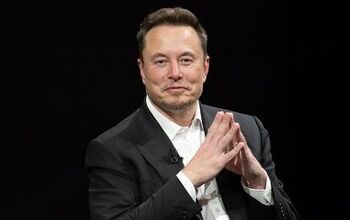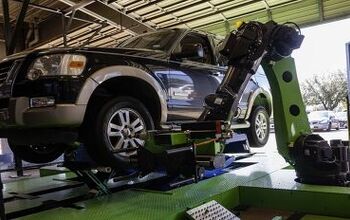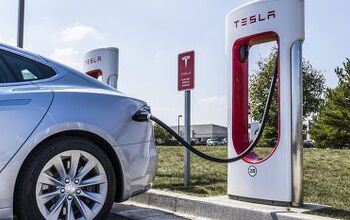Siry Slams DOE Loan Program For "Stifling Innovation"
Former Tesla PR honcho Daryl Siry lays into the Department of Energy’s Advanced Technology Vehicle Manufacturing Loan program (ATVML) at Wired’s Autopia blog, taking the $25b program to task for “stifling innovation.” At its core, his argument is a simple one:
Startup companies that enjoy DOE support, most notably Tesla Motors and Fisker Automotive, have an extraordinary advantage over potential competitors since they have secured access to capital on very cheap terms. The magnitude of this advantage puts the DOE in the role of kingmaker with the power to vault a small startup with no product on the market -– as is the case with Fisker — into a potential global player on the back of government financial support.
As a result, the vibrant and competitive market for ideas chasing venture capital that has been the engine of innovation for decades in the United States is being subordinated to the judgments and political inclinations of a government bureaucracy that has never before wielded such market power.
All of which sounds very TTAC… in fact, our lengthy Bailout Watch series began with a similar analysis of the ATVML program (albeit with a Detroit-focused twist). Unfortunately, Siry’s intentions in this case are questionable… as are his conclusions.
At the very bottom of his editorial, Siry reveals himself to be a “special advisor to Coda Automotive,” the EV startup born from the ashes of Miles Electric Vehicles. That Coda has not sought an ATVML handout (because all its manufacturing is done in China) is presumed to give Siry a free pass on conflict-of-interest questions, but Siry’s critique relates directly to the private capital market as well. Siry writes:
The proposition is so irresistible that any reasonable person would prefer to back a company that has received a DOE loan or grant than a company that has not. It is this distortion of the market for private capital that will have a stifling effect on innovation, as private capital chases fewer deals and companies that do not have government backing have a harder time attracting private capital. This doesn’t mean deals won’t get done outside of the energy department’s umbrella, but it means fewer deals will be done and at worse terms.
Translation: Coda can’t raise funds without DOE backing, a reality the company petulantly hinted at in the most recent post on its corporate blog. There, the company lashed out at analyst suggestions that DOE loans would be best spent on established automakers, and now Siry is bashing the DOE’s “kingmaking” of “small startups with no product on the market.” So which is it? The answer can be found in Siry’s conclusion:
A potential solution to this problem may seem counter-intuitive. The best way to avoid market distortion would be for the DOE to cast the net more broadly and provide loans and grants to a larger number of companies — which ironically means being less selective. Subject to the existing equity matching requirement, this would allow the private markets to function more effectively in funding a broader range of companies and driving more innovation. Several innovative companies with great potential have been in the DOE pipeline for many months. Perhaps it is time for the DOE to stop playing favorites and start spreading the love.
Give out money to more firms, less selectively. What a plan. But if Siry is suggesting that Coda Automotive represents the kind of “innovation” being “stifled” by the ATVML program, he’s able to see far more innovation in selling an electrified Chinese Hafei sedan with 100 miles of range for $45k than we do (he doesn’t explicitly, preferring Aptera as a poster child for stifled innovation). The reality is that the EV sector is crammed with as many hucksters and wannabes as legitimate innovators, and “spreading the love” is more likely to result in wasted investments. In theory we agree that DOE “kingmaking” distorts the market, and elevated some questionable firms to near-player status… but interpreting those results as a reason for the DOE to be “less selective” with its lending makes even less sense. Unless, of course, you work for a firm that might benefit from lowered loan standards.
As a lesson in the ATVML’s unintended consequences, Siry’s editorial is dead-on. As a roadmap for future DOE policy, however, it comes up way short.
More by Edward Niedermeyer
Latest Car Reviews
Read moreLatest Product Reviews
Read moreRecent Comments
- MaintenanceCosts Nice car if you can get it properly sorted, but the level of safety tech doesn't seem quite enough for a young driver on today's brodozer-infested highways.
- VoGhost OK. But if Subaru really wants this to sell, they'd make it as a PHEV with enough American content to get buyers $7,500 back on their federal taxes. Otherwise, this really doesn't stand out in a world of RAV4s and CR-Vs.
- VoGhost Tesla has an average of 28 days of inventory, less than half industry average.
- FreedMike Ah, Chesterfield Mall...my old teenage stomping grounds. Bummer what happened to it, that's for sure. But that's what happens when the city council approves not one, but two "premium" outlet malls right down the road to be built. That killed this mall dead.And in case anyone's interested...yes, Teslas and other EVs are very popular in that neighborhood.
- MaintenanceCosts Subarus can be durable, but they are going to demand more frequent and expensive regular maintenance than your typical Honda or Toyota. I suspect for a lot of third and fourth owners that means the economic equation favors scrapping them a bit earlier.


































Comments
Join the conversation
A quick check and I found mention that NASA is credited for 1400 inventions that have found their ways into our lives at home or in industry. Then there are national laboratories and the military scratching their collective noggins daily. There is plenty of evidence pointing to the idea that big oil and by extension Detroit are hindering advancements in EV production. Note that I did not say research because aside from battery improvements the rest of the technology is tried and true. See the RAV4-EV from about ten years ago. They are still on the road and most are still using their original NiMH batteries to go 100 miles+ with all the standard creature comforts. Chevron bought the NiMH patents from GM and then shelved them. We could have hybrid batteries but not EVs. I find it an advantage NOT to carry around a whole internal combustion engine like the Volt. Save the weight, cost and complexity and put in a couple more batteries. How far is your commute? Our's is less than ten miles and less than 60 miles. Listen - we either get our heads right on the idea of funding innovation and building green tech like EVs, solar and wind to supplement the internal combustion engine and coal power or we'll find ourselves buying yet more sh!t from China as they kick our backsides in yet ANOTHER category. We'll be busy debating who has the right to criticize our choice to drive pickups and SUVs when China quietly invades our markets with all their green tech and we'll miss out on the opportunity to buy stuff made in America that delivers American paychecks. I'm serious. The rest of the world is moving forward on green tech whether we like it or not. We have the opportunity to build our own or we'll find ourselves surrounded with more imported goods. America is like GM right now. We're sitting in the meeting room explaining to each other how we don't like some new market reality when we ought to be hiring some more engineers and working hard to get the best possible product to market RIGHT NOW. Instead we'll sit on our hands and watch some Asian company produce something that is better and lasts longer and makes a nice profit. Then we'll continue to sit around and talk about how much better our product is but we've missed the opportunity to prove it. We'll be playing catchup while losing customers. The US gov't ought to be funding the green tech research and also buying and installing it on gov't properties. A private citizen might argue that they don't want to invent in $40K worth of solar to put on a house they may not own in a decade but the gov't has alot of properties that they'll own far beyond the estimated 30-40 years lifespan of a solar system. In fact we don't even really know how long solar lasts because the 1970s solar panels are still putting out 80%+ of their original ratings. The gov't could certainly use EVs for mail delivery and other local trips.
Suggested for reposting: "A large part of the electric car projects are just a scam to get a certain group of VC's to control the lithium fields in Afghanistan! He who controls the electric cars controls the trillions of dollars of lithium revenues. It is just like oil all over again. The U.S. Department of Energy had one guy, who George Bush appointed running $25B worth of taxpayer money. He was working with 3 other guys in this small group who gave the money only to hooked n car companies who they could control the battery orders for and thus control the Lithium profits. Dmitry Medvedev Came to Silicon Valley on June 22, 2010 and met with some of the venture capital companies that helped lobby the leverage for the electric car companies that just got funded. Only the car companies got funded that would play in this scheme. Ener1 Battery Systems who got zillions of the dollars from DOE per the Loan Guarantee and ATVM Director Seward. Is controlled in part by Russian “business man” Boris Zingarevich. Who is best friends with the Russian Dmitry Medvedev, who arranged for all of Russia to extend current agreements signed with foreign automakers between 2005 and 2008 granting preferential duties on imported components for eight years in return for sourcing 30 percent of parts locally, according to the Industry and Trade Ministry. Once those arrangements expire, the carmakers would need to commit to buying 60 percent of components in Russia within six years to get more tax breaks. Dmitry also appears to own interest in lots of Lithium processing and mining company technology in Russia which is pretty close to Afghanistan. Afghanistan is: the "Saudi Arabia’ of lithium". American geologists have discovered huge mineral deposits (Many $1 trillion of dollars worth) throughout Afghanistan, according to the New York Times. Lithium, gold, cobalt, copper, iron, among other valuable minerals are lying beneath what is already a war-torn country with little history with mining. Off and on over the decades, geologists—Soviet, Afghan, American—would investigate and chart some of Afghanistan’s mineral wealth, only to put the work on hold as violent conflict erupted. Now, corruption, in-fighting between the central and district governments, foreign interests, and greater zeal from the Taliban might come into play to disrupt a potential economy evolving around these natural resources. With the Ministry of Mines, a Pentagon task force is now helping organize a way of handling the mineral development and bidding rights. How this unfolds socially, environmentally and politically should be interesting. The New York Times reports: The value of the newly discovered mineral deposits dwarfs the size of Afghanistan’s existing war-bedraggled economy, which is based largely on opium production and narcotics trafficking as well as aid from the United States and other industrialized countries. Afghanistan’s gross domestic product is only about $12 billion. The two most prevalent minerals are copper and iron. Niobium, used for making superconducting steel, has also been found. The effort to get that money for Ener1 was strong armed by Republican Sen. Richard G. Lugar, one of the deans of Congress, and his junior colleague, Democratic Sen. Evan Bayh. Richard Lugar and Lachlan Seward co-managed the Chrysler Bail-out. Lachlan Seward was appointed by George Bush to run all of the tens of billions for the DOE ATVM and Loan Guarantee Programs. He & Matt Rogers gave most of the money away to their closely aligned interests and negated competing applicants. -- Another place near Afghanistan that there is lot's of Lithium is in Mongolia. Blum Capital has targeted the Lithium fields in Mongolia, said to be the second largest fields after Afghanistan in the region. Mongolia touches Russia so mining and equipment access could first take place there via Russia. China wants the Mongolian Lithium too so there is some two-way bidding that each country (Russia and China) do not know about. The owner of Blum Capital is Senator Feinsteins husband. She recently made him the Goodwill Ambassador to Mongolia. Blum's wife, Senator Dianne Feinstein, has received scrutiny due to her husband's government contracts and extensive business dealings with China and her past votes on trade issues with the country. Blum has denied any wrongdoing, however. Critics have argued that business contracts with the US government awarded to a company (Perini) controlled by Blum may raise a potential conflict-of-interest issue with the voting and policy activities of his wife. URS Corp, which Blum had a substantial stake in, bought EG&G, a leading provider of technical services and management to the U.S. military, from The Carlyle Group in 2002; EG&G subsequently won a $600m defense contract. In 2009 it was reported that Blum's wife Sen. Dianne Feinstein introduced legislation to provide $25 billion in taxpayer money to the Federal Deposit Insurance Corp, a government agency that had recently awarded her husband's real estate firm, CB Richard Ellis, what the Washington Times called "a lucrative contract to sell foreclosed properties at compensation rates higher than the industry norms. Pan American Lithium Corp is led by Andrew Brodkey, CEO, President and Director – who has 25 years in the mining industry as a mining engineer, lawyer and senior executive with a focus on corporate legal and business development activities at major mining companies with an emphasis on Latin America, including Magma Copper Company and BHP Copper Inc. Mr. Brodkey also created the International Mining & Metals Group of CB Richard Ellis, Inc (“CBRE”). He and Mr. Blum work together on Lithium deals " In 2009 the University of California Board of Regents, of which Blum is a member, voted to increase student registration fees (roughly the Univ. of California equivalent of tuition) by 32%. Shortly thereafter, Blum Capital Partners purchased additional stock in ITT Tech, a for-profit educational institution. These events suggest a conflict of interest on Blum's part. Also see: http://la.indymedia.org/news/2010/09/242044.php and http://www.floppingaces.net/2007/04/02/the-silence-on-the-feinstein-c/ and http://www.washingtontimes.com/news/2009/apr/21/senate-husbands-firm-cashes-in-on-crisis/